"I sync, therefore I am. (My Speed sure is)"
It can be very useful to have an electronic flash unit coupled to use Studio Flash lights or a small flash as fill-in with barrel lenses.
With the right cable, we could connect our Flash-unit directly with the built-in Focal Plane sync port (Bi-post).
Shutter speeds are indicated through a sealed window. The 2 speeds 1/250 and 1/1000 are marked in black to indicate that they may be used with long-peak flash lamps only.
The other speeds are marked in red, indicating that flash can not be used.
Provision is made for time exposures with the focal plane shutter by means of an additional curtain opening the full width of the picture area.
Electronic flash and types M and F can be used at this setting. This is accomplished by pressing the exposure button twice as quickly as possible.
The setting will show as T in the window. Now we push the shutter release, the flashlight or strobe will be triggered just as the curtain has completely uncovered the film area. The second pressure on the trigger is to close the curtain again and should be done as quickly as possible to avoid fogging of the film....
We have tested this procedure and it will work when ambient light is low. (Likely ambient will be low. Any readout of the meter indicating a longer exposure than 1/15 at f2.5 has to be considered as low)
|
The less cables the better....
Ideal situation would be to sync without cables, laying all around the working space. The solution is remote triggering!
Devices for the remote triggering of flash units fall into two categories, infrared (IR) and radio frequency (RF). Of the two, RF devices are the more versatile. With RF systems, the transmitter and receiver don’t need to be in line of sight of one other, they perform equally well in bright sunlight and a darkened studio, the distance over which they operate reliably is greater than IR systems, and RF systems offer more available channels.
|

Sync cable for FP Speed Graphic - Tip Bipost (female) cord Tip PC (female)
|  |
Get synced part 1:
This cable on the left is the "pièce de résistance".
Hard to get on Ebay or at your local Mall. Unfortunately this rare cable is the one to look for.
Be warned, cables offered are brittle most of the time and can result in severe short-circuits !!
If you are lucky to find a decent one, you will notice it has one tip for the sync on the FP (Bi-post) and the other end a PC male tip.
To connect to a sync cable however we need a PC female (If you do not know what the "female" part means, I am not going to be the one to tell you. Think about it.) on the other end....There are little connectors (PC male - 3x PC female), but this is not a very secure connection!
If all fails, the cable can be ordered though at ParamountCord. You will need a cable with tips # 13 and # 14.
NOTE:
About cable tips - Male is called plug, whereas Female also is called socket!
|
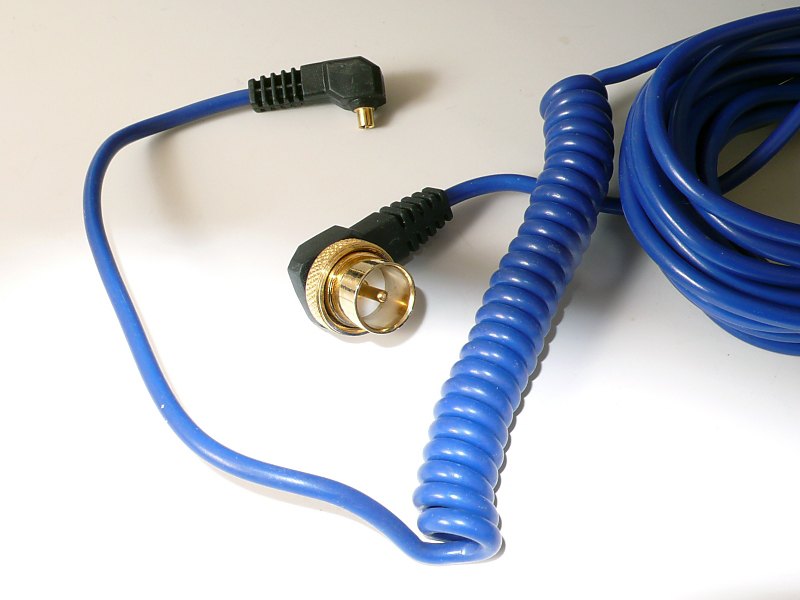
Elinchrom sync cable PC tip( male) - to connect with Camera or with PC tip Speed Graphic cable
|  |
Get synced part 2:
If you have access to a Studio Flash installation, you will need a longer cable though.
Those units all have different connections but the one to the camera is always PC male. Now you will understand why the cable above is preferred, while having a female PC tip.
|
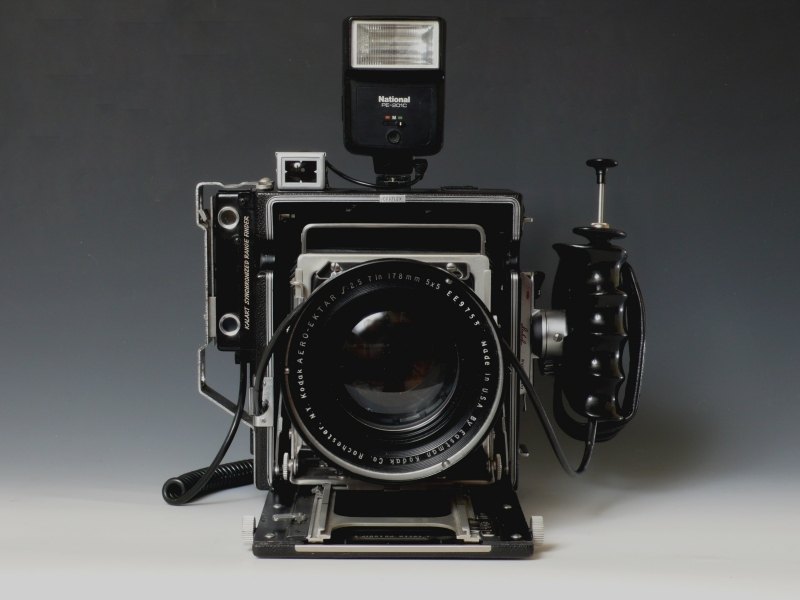
Small flash unit (Guide nr 14 / 100 Ansi - Can be used as fill in light and/or trigger multiple strobes.
|  |
Go wireless part 1:
When we have the proper cable it is no problem to connect and sync the FP shutter with a small flash unit on top of the camera..
This little unit can trigger larger units when they have slave cells attached.
The biggest problem if we want to work wide open (f 2.5) is to minimize the output of the flash units.
You need a flash-meter to control the light.
|

Minolta Receiver/Transmitter. - Receives IR signal from flashmeter IV and sending IR burst to trigger Flash units with slave cells adapted.
|  |
Go wireless part 2:
Cables around can be a hassle. First approach is the use of the Minolta receiver/trigger.
The gadget receives a IR signal from the Minolta flashmeter IV and triggers the flash in the non-cable mode.
Without any cable we can thus measure the flash output with just one push on the button. However, we have still to connect the sync of the focal plane shutter with one of our strobes...
|
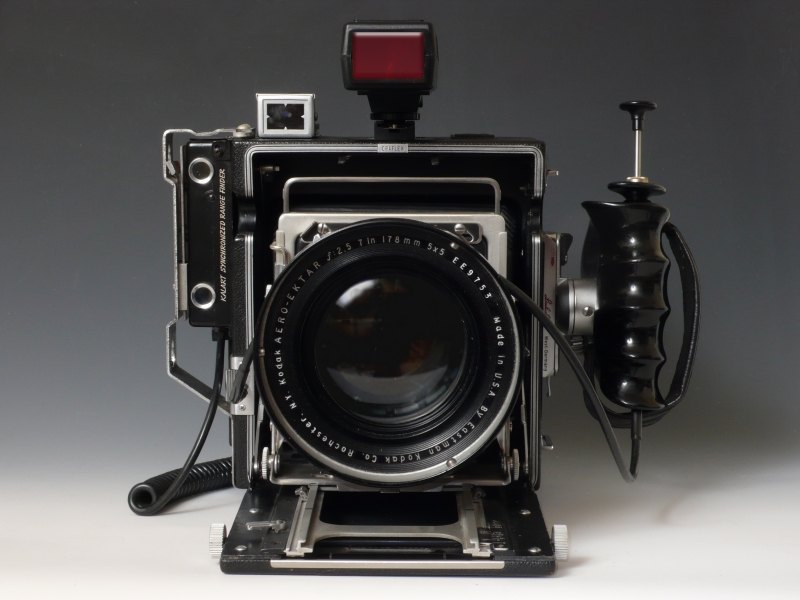
IR remote trigger - Triggers all flash units wiith slave cells mounted. (does not go through walls...or rounding corners)
|  |
Go wireless part 3:
A more elegant solution can be the use of an IR remote trigger on the camera, connected with a cable to the FP sync.
When we will trip the shutter on T, the unit will send an IR burst to the strobes. The slaves on the strobes or smaller units with a coupled slave cell will flash with a slight delay. (can be safely ignored.)
To measure the light, we need the help of a third hand or we have to connect the meter with a cable. One can't have all :-)
|

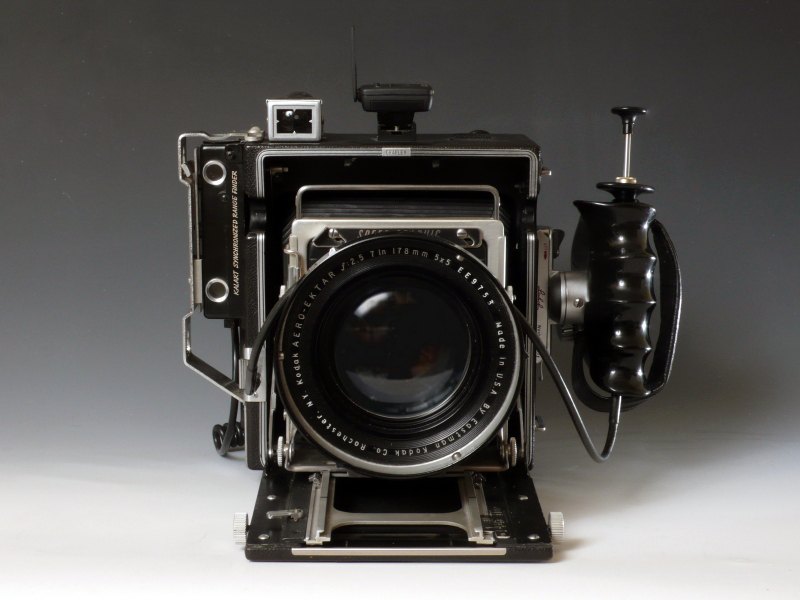
Elinchrom SkyPort Universal - 2.4ghz RF, 8 channels, 40bit security
Syncs at up to 1/1000
165ft indoor range and 395ft outdoor range
4 workgroups for different control options

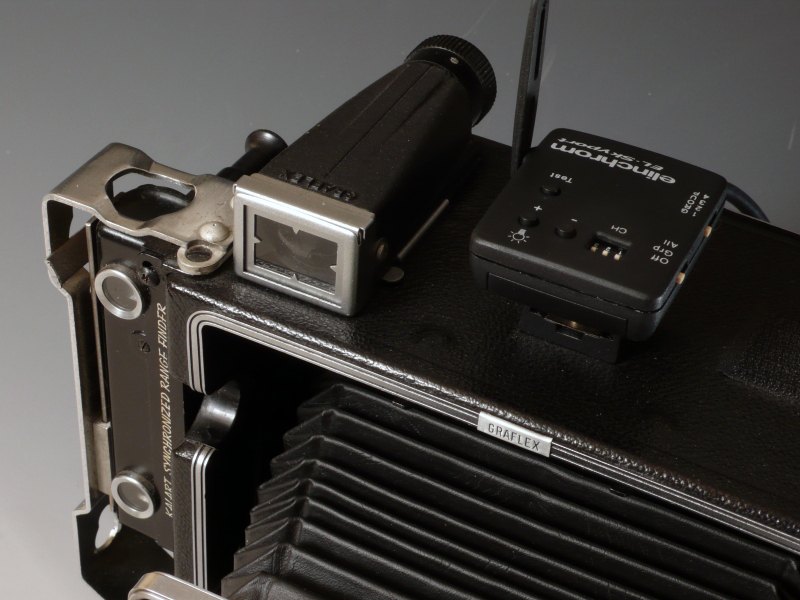
Elinchrom SkyPort Universal - 2.4ghz RF, 8 channels, 40bit security
Syncs at up to 1/1000
165ft indoor range and 395ft outdoor range
4 workgroups for different control options
|  |
Go wireless part 4:
Complete cable freedom can be experienced with a Radio Remote Control.
Coming in several flavors (1 - 4 channels) and prices (Euro 60 -360). You will need a receiver and also a transmitter. The last mentioned has to be mounted on the camera, whereas the receiver is connected with one of the leading strobes (MainLight).
A one-channel radio remote control set will do just as fine for our Speed Graphic.

Well, actually I have 2x 500Ws and 1 1000Ws Elinchrom units, thus the best choice was to get the SkyPort Universal Radio Remote Control from Elinchrom.
The Elinchrom Strobe units use the special AMPHENOL PLUG to screw in. The universal set came complete with the amphenol jack. That's why ! Almost forgot, the Skyport is very unobtrusive and very low profile also!
Advantages Radio Remote Control
- No cables around to trip on.
- Reliable triggering of your strobes.
- Signal will go through walls and glass.
- Working up to 25 meter and some.
- No disturbance from cell-phones and the like.
The Skyport plug is connected with the FP sync post, thus from now on the Speed is wireless in Studio environments....
Finally, I have to adapt some cables for my smaller flash units.
|

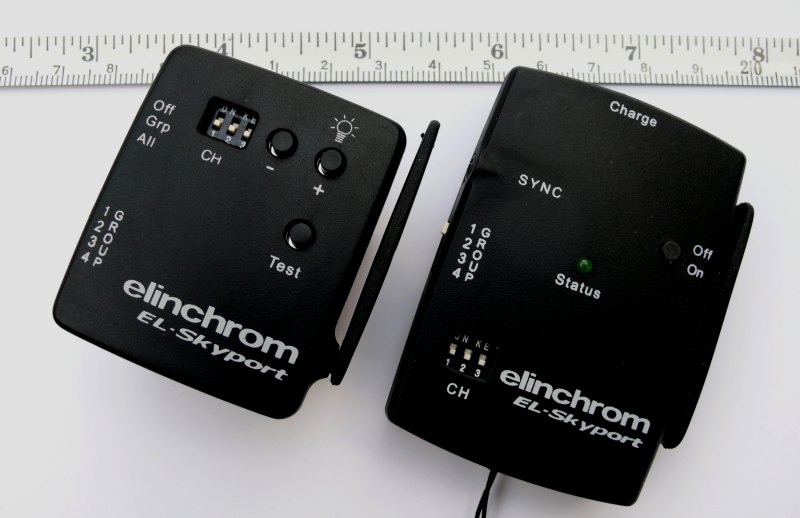
The smallest Radio Remote control on the market. EL-Skyport Universal
|  |
Size of the unit
On the left you can get an impression of the actual size of the units.
The smallest one is the transmitter with a hot-shoe and plug to X-contact. The other one is the receiver.
Weight is only 30 gram for the tranmitter and 50 gram for the receiver.
NOTE: It speaks for itself, I did not buy this unit for the Speed Graphic exclusively....
|


PLUCK YEW
|  |
Go wireless part 5:
On the left an example, shot sometime ago with a borrowed transmitter in the open.
It is nice to control the light....
As you have noticed already, this image has been shopped recently just a little.
|
|
NOTE on the Image above: Not what you think..!
Giving the Finger
Before the Battle of Agincourt in 1415, the French, anticipating victory over the English, proposed to cut off the middle finger of all captured English soldiers. Without the middle finger it would be impossible to draw the renowned English longbow and therefore be incapable of fighting in the future. This famous weapon was made of the native English Yew tree, and the act of drawing the longbow was known as "plucking the yew" (or "pluck yew"). Much to the bewilderment of the French, the English won a major upset and began mocking the French by waving their middle fingers at the defeated French, saying, "See, we can still pluck yew! "PLUCK YEW!" Since 'pluck yew' is rather difficult to say, the difficult consonant cluster at the beginning has gradually changed to a labiodental fricative 'F', and thus the words often used in conjunction with the one-finger-salute are mistakenly thought to have something to do with an intimate encounter.
It is also because of the pheasant feathers on the arrows used with the longbow that the symbolic gesture is known as "giving the bird".
And yew thought yew knew everything.
|
|
Fingering a popular myth.
(Update, from one of our readers)
According to a popular myth the "two-fingers salute" and/or V sign derives from the gestures of longbowmen fighting in the English army at the battle of Agincourt. The myth claims that the French cut off two fingers on the right hand of captured archers and that the gesture was a sign of defiance by those who were not mutilated. (This false etymology has also given rise to an alternative name for the gesture, which can also be known as flicking an "Archers Salute" or just "Archers" as in "He just flicked me an Archers!") The website Snopes, however, shows that medieval warriors had no interest in capturing common archers that could not be held for ransom, preferring instead to simply kill such prisoners. Furthermore, mutilating a prisoner to stop them from using a bow would not make sense, since killing them would stop them from ever serving the enemy again. There is also the fact that contemporary accounts of the battle make no references to the French mutilating their prisoners by cutting off fingers from their hands. The first definitive known reference to the V sign is in the works of François Rabelais, a French satirist of the 1500s. )
The belief that the V sign originated among archers might have its origin in the work of the historian Jean Froissart (c. 1337–c. 1404), who died before the Battle of Agincourt took place. In his Chronicles, he recounts a story of the English waving their fingers at the French during a siege of a castle, however he makes no reference to which fingers were used meaning that this is not evidence of the origin of the V sign.
The "two-fingers salute" is certainly older than Agincourt. It appears in the Macclesfield Psalter MS 1-2005 Fitzwilliam Museum, Cambridge, believed to be produced in about 1330, Folio 130 Recto, CDROM p261, being made by a glove on the extended nose of a marginalia depicting a human headed hybrid beast, ridden by a person playing the pipe and tabor. The Psalter marginalia have many absurdities and obscenities so the traditional meaning of this gesture would not be out of place here. As the gesture is made by a disembodied glove accidental positioning of the hand may be ruled out.
|

 |
This page has been published and updated on October 4th 2007
All tests were carried out by John D. and Leo M. at a Studio in Driebergen-Rijsenburg. The gadgets examined were in random order: Minolta IR Receiver/trigger, National Flash PE 210-EC, Prolinca IR transmitter, Elinchrom EL Skyport. Strobes used were the Elinchrom 1000 (1x) and Elinchrom 500 (2x). Synced (Bi-post male on the FP shutter) Camera was the Speed Graphic Pacemaker 45.
|

COPYRIGHT NOTICE:
PUBLISHED PHOTOGRAPHS NOR TEXT MAY USED WITHOUT WRITTEN CONSCENT OF THE AUTHOR.PHOTOGRAPHS MAY NOT BE CROPPED, RETOUCHED OR
AIRBRUSHED IN ANY WAY WITHOUT THE PERMISSION OF JOHN D. PHOTOGRAPHY.ALTERING THESE PHOTOS WITHOUT PERMISSION WILL RESULT IN CHARGES FOR DAMAGED PHOTOGRAPHS.THERE WILL BE WHATSOEVER NO CAPTURING,
RESAMPLING, SCANNING, DIGITISING OR STORAGE OF IMAGES ON A RETRIEVAL SYSTEM WITHOUT THE WRITTEN CONSENT OF THE AUTHOR. THE
NATURE OF THE CAPTIONS MUST BE RESPECTED.ALL THESE PHOTOGRAPHS ARE COPYRIGHT OF JOHN D.PHOTOGRAPHY & JOHND.ESQ © 1999,2007
|

This page is part of "The MasterSite for the larger camera"













